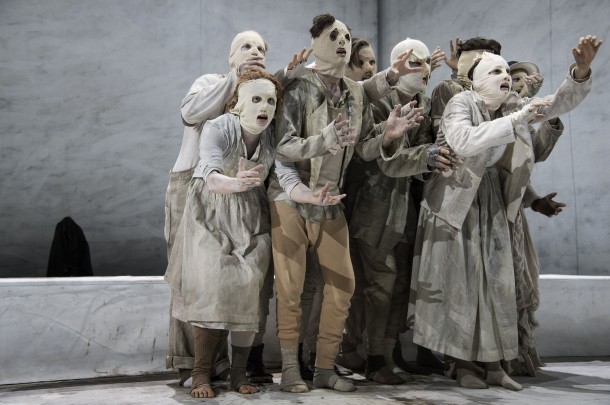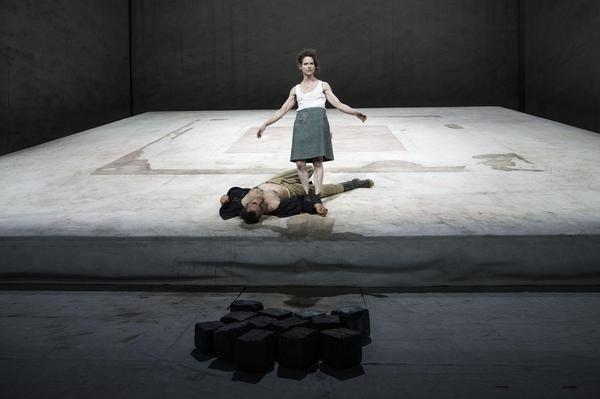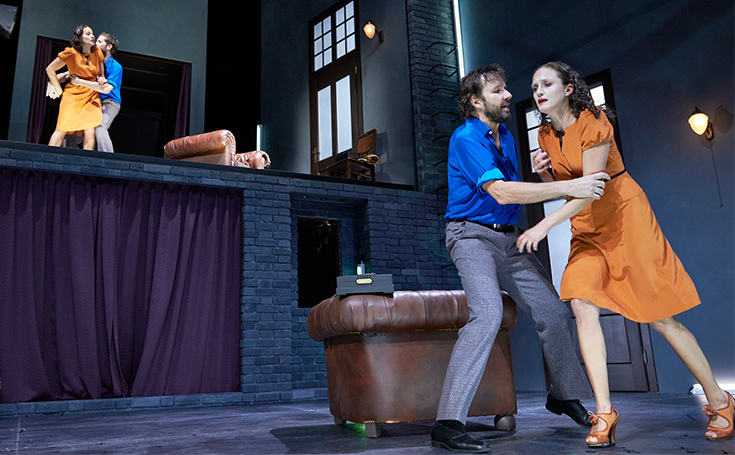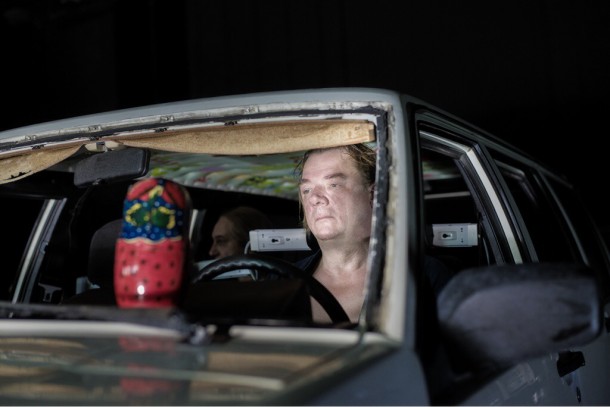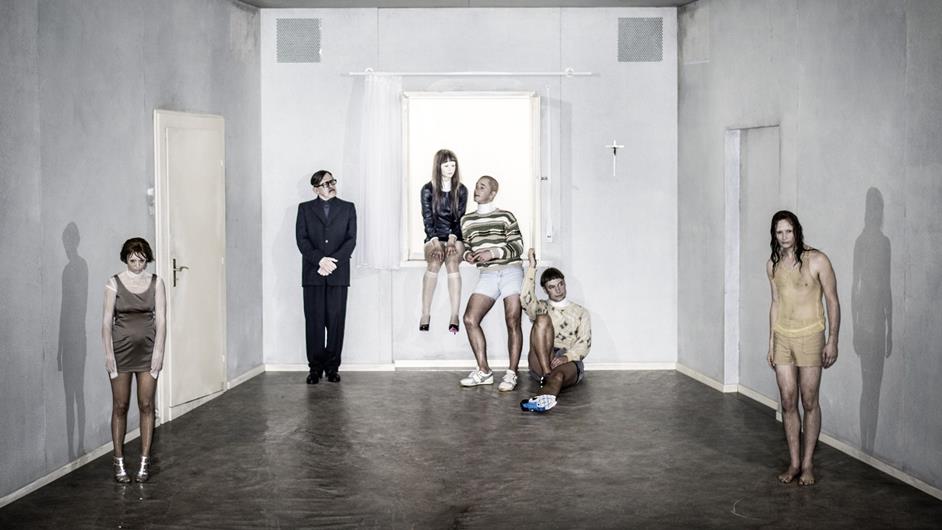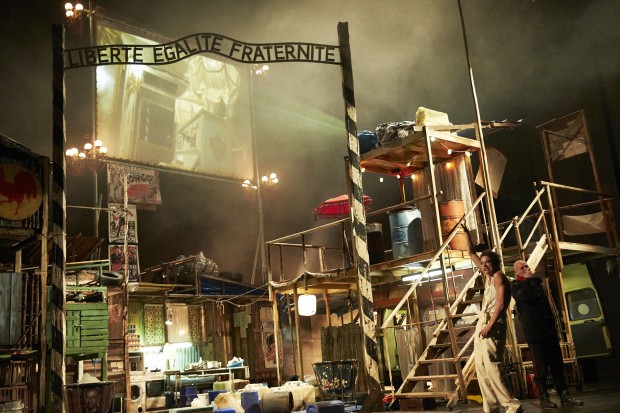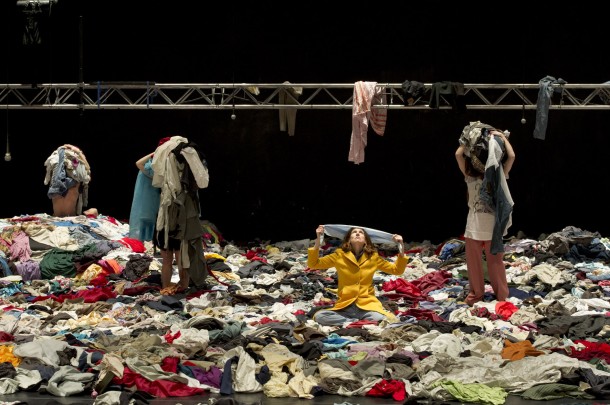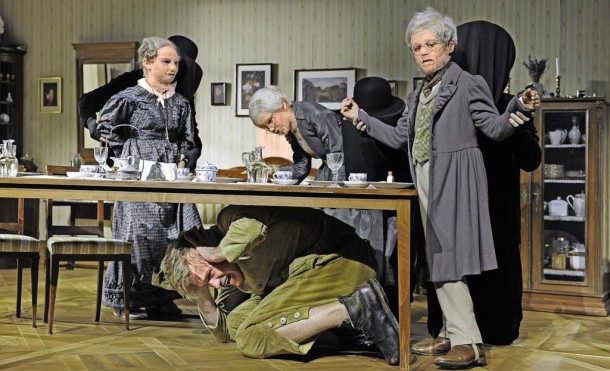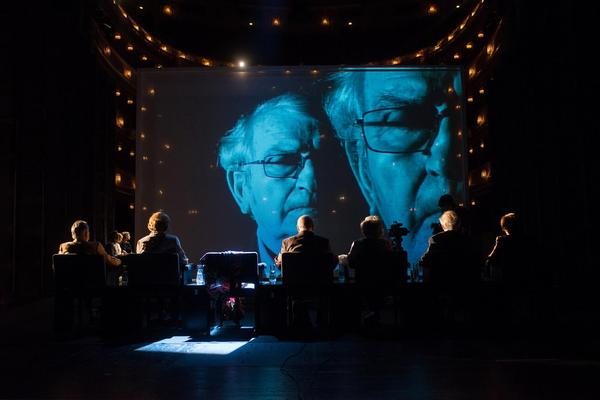Particular homage was given in this year’s Berlin theatre festival to the work of the leading director Dimiter Gotscheff, who died this spring. His final production, and among his most impressive, of Heiner Müller’s Zement, created for the Residenztheater in Munich, headed off this year’s festival, which actually opened with an address by Alexander Kluge honoring poet and playwright. During the Theatertreffen three other Gotscheff works were presented at the Berlin theatres where they were first produced, a number of film documentations of his work were shown and an exhibition of the work of Gotscheff’s set designer Mark Lammert was on display in the Festival theatre.
Although the three hour, fifteen minute production of Zement might have profited from some judicious cutting, its very monumentality was part of its effect and it served as a fitting memorial for both author and director. Müller’s play is based on a 1925 novel of the after-effects of the Russian Revolution by Fyodor Gladkov. It is basically a study of a group of small town figures, all deeply touched by the upheaval and yet left far from the utopia for which they sacrificed so much. The central figures are the returned veteran Gleb Chumalov, whose fellow citizens beg him to rebuild the destroyed cement factory and restore the town to prosperity, and his wife Dascha, who gave up her child and domestic tranquility to sacrifice all for the cause. The production might have moved in the direction of realism, but that would have been most uncharacteristic of Gotscheff. Taking his cue instead from the many classical references in the work, Gotscheff presents it as a kind of modern Greek tragedy, with lime-coated seemingly dead villagers as his chorus and Gleb, often carrying a block of cement, as a kind of Sisyphian Prometheus.
Their child Njurka (Valery Tscheplanova) abandoned and now dead, appears at the beginning, end, and occasionally in between as an ethereal figure whose wails and melancholy songs provide the basic tonality of the evening. The setting, by Ezio Toffolutti, is suitably stark and monumental. It is essentially a giant box composed of concrete-grey curtains, the one at the rear containing three slits for entrances. The floor, a giant grey slab that can be tilted upward toward the audience at various angles, contains at its center the scarred outlines of the razed factory. Aside from the block of cement carried, and occasionally dashed to the stage for effect, by the leading actor, there are no properties other than a group of smaller similar blocks, occasionally similarly used by the chorus.
The chorus, almost always on stage, is powerfully and imaginatively utilized throughout, and even occasionally achieves surprising and effective moments of gaiety and humor, as in the occasional sequences when, recalling the euphoria of the revolution, they join Gleb in a joyous improved revel, or when they surround a Soviet bureaucrat and imitate the noises and movement of his typewriter keys as he creates another of countless public pronouncements.
The center of the evening however is devoted to the husband and wife Gleb and Dascha, played by two outstanding actors long associated with Gotscheff, Sebastian Blomberg and Bibiana Beglau. Their extended scene in the second part, in which Dascha reluctantly but uncontrollably slowly reveals to Gleb her sacrifice and degradation for the cause while he was away fighting, is deeply moving, and at times almost unbearable in its intensity. At the end, when they mime their mutual suicides down center and slowly sink downward out of sight, the play is effectively over, although the slowly departing chorus and the singing child carry the mood off into the darkness. Müller himself saw his dark portrayal of the sufferings of the populace as a reminder of the price already paid for the revolution and an encouragement to continue the struggle, but especially in this production it struck me much more as an elegiac study of the continuation of human suffering in a cruel and uncaring world. The struggle does not seem hopeless, but it does seem a long and difficult, if necessary one, and one which no one living can expect to see come to a positive end.
The second production of the festival came from the Zurich Schauspielhaus. This was Amphitryon und sein Doppelgänger, quite freely adopted from Kleist’s Amphitryon by director Karin Henkel and dramaturg Gwendolyne Melchinger. The relationship of adaptation to original is rather like that of Shakespeare’s The Comedy of Errors to Plautus’ The Menachmi. The simple and relatively straightforward confusions of the original have been much elaborated and turned into a comedy of shifting identities, resulting in something closer to the constant confusions of French farce than to the rather more troubling meditations on identity and eroticism in Kleist.
The setting by Henrike Engel situates us at once in a world of contradictory impressions, rather like a painting by Magritte. Interior walls are mixed with exterior ones, windows open onto moving images of city-scapes, whirling about as if seen in a delirium. The main downstage area suggests a courtyard, but its main feature is a living-room armchair. There is really no conventional lighting. Actors seated in the armchair can turn on a spotlight mounted on a metal pole near the chair. Upright neon tubes here and there on the stage provide the other major illumination, along with low downstage spotlights which regularly throw large shadows of the characters on the walls, increasing the doubling effect (the lighting is by Michel Günert).
The opening sequence sets the tone of the evening. An actor in hat and trenchcoat enters in semidarkness, turns on the stage light by the armchair and settles in. Almost at once there is a noise outside and he turns out the light and hides. A door in the right wall opens and another actor, identically dressed, is blown onto the stage like Charlie Chaplin in The Gold Rush cabin. This sequence is reproduced identically another three times until the entire company of five has been introduced, two women and three men, all in the same costume (designed by Klaus Bruns). Gradually we learn that this costume represents Amphytrion’s servant Sosie, but it as well as the character can be assumed by anyone. Almost as fluid is Sosie’s wife, Charis. The three central characters are only somewhat more fixed. Basically Michael Neuenschwander plays the cuckolded Amphytrion and Fritz Fenne the philandering Jupiter, but as in the original the basic situation of the play is their overlap, and neither they, the other actors, nor the audience can ever be fully sure which is which, especially when, in several scenes, “Amphytrion” and his wife “Alcmene” are played by two identically dressed couples simultaneously on an upper and lower stage.
Like a French farce, the confusion steadily builds until by the closing sequence the characters themselves desperately try to clear things up by printing their names on labels and “Charis,” challenged to reveal her “real name,” gives the name of the actress, Marie Rosa Tietjen, only to be challenged by the real Tietjen, who earlier alternated with Lena Schwartz in playing Alcmene. This other Tietjen exposes the false Tietjen as the actress Carolin Conrad, carrying the play’s confusion out into the casting itself. Only audience members already familiar with the actual actors can be sure what is the truth they hear.
The miraculous appearance of the God Mercury does not bring resolution, but only further confusion, as he is interested only in eating wurst and sauerkraut until he is, inevitably, replaced by another claimant to his title. The logic, or anti-logic is that of a dream of infinite regress, which Hinkle suggests, is the world represented by Jupiter. Clearing the stage, the god calls, as a closing theme song of the production, an electronic rending of the Talking Heads, singing “Heaven in a place where nothing happens.”
Both Gotscheff and Hinkle are familiar figures at the Theatertreffen, each with several invitations in recent years. The third director, Robert Borgman, is a newcomer, with an Uncle Vanya from Stuttgart, one of a number of major German stages where his work has appeared. To an Anglo-Saxon viewer Borgman’s work is likely to appear outrageously unconventional, far from any expected approach to Chekhov, but within a German context, paradoxically, his approach is totally familiar. It is very much in the tradition of German Regie-theater, or director’s theatre, in which the director imposes his or her own radical reinterpretation on a text, often by one of the standard classic authors—Shakespeare, Schiller, Ibsen, and Chekhov. It is a familiar German pattern for emerging directors to place themselves on the theatrical map by presenting a Regie-theater production of one of these authors at the annual Theatertreffen. Almost every major new director of the last several decades, from Frank Castorf to Herbert Fritsch, has followed this pattern, and so in this sense Borgman, even in his unconventionality, is completely conventional.
The audience is signaled from the very beginning that they are in for an evening of departures from the tradition. There is not a scrap of traditional Chekovian realistic scenery on the huge, basically empty stage. Instead a large circle of identical white chairs is seen in the middle of the stage, being slowly circled by a white Volvo sedan, which remains onstage all evening but only continues its unquestionably distracting circling for the first act. The action begins as Elena (Sandra Gerling) appears on stage, dressed, inexplicably, in an American flag, with a badminton racket and bird and carries out an extended badminton exchange with a presumed audience member. Aside from perhaps indicating her frivolity and boredom, there is really little here to lead us into the play but it is a clear signal of what sort of production Borgman is offering.
So desolate an emotional landscape has rarely been seen in a Chekhov production. Vanya (Peter Kurth) moves and speaks almost catatonically, with long pauses, making the three and a half-hour production seem even longer, but every so often he bursts into frantic energy, hurling himself in frustration against the walls or tumbling in and out of the rotating car. His mother (Susanne Böwe), who never really emerges as a character, sits in the circle of chairs at the opening, slowly rolling up a skein of wool that stretches across the stage and out of sight. Only near the end do we see that Vanya is tethered to the other end floating in the air like a balloon (with the aid of a large and visible crane). Talked into descending, he spends most of the final sequence sitting quietly depressed in various locations on the stage, as Sonya (Katharina Knap), the only fairly sympathetic and human of the characters, speaks her final, somewhat desperate affirmation of hope. Throughout the evening the main light has been a cold neon one, and for this final speech, a huge, cold neon sun or star swings down on stage to provide backing for her. In its light the long-silent Vanya speaks the closing word, an empty, resigned “Aua.”
Sharing the center of the production with Vanya is Thomas Lawinky as Astrov, the doctor, who takes the doctor’s drunkenness as the basis of his character, playing the entire evening either in an alcoholic stupor (as when he stumbles as if by mistake into one of the audience boxes near the beginning) or in a kind of manic frenzy, as when he and Vanya pantomime a frantic, very funny, and not particularly explained violent sequence involving wrecking the car and various acts of related mayhem. The doctor’s description to Elena of his drawings is another key sequence performed in a strikingly unconventional manner. Instead of actually showing her sketches (in a straightforward manner now often used by German directors for their current relevance to concerns with climate change), Lawinky plays the whole scene in an hallucinatory state, virtually ignoring Elena as he rushes about the stage, referring to sketches that clearly exist only in his deranged mind, expressing a paranoic fear that mosquitos are taking over the world, and seeking protection in a huge white plaster frog that he carries as a kind of talisman.
Among the other characters, only Sandra Gerling as Elena is a significant presence, but she commands attention throughout with her strident voice (vocally and physically the production recalls the extremes of the early Castorf) and her bizarre series of costumes, from the American flag to parodies of contemporary high fashion. Elmar Roloff, the professor, spends most of the evening wondering vacantly upstage, though he does present a rather charming if manipulative figure in his one big scene where he announces his plan to sell the estate.
In Stuttgart, the production apparently received very strong negative reactions from the audience, but Berlin Theatertreffen audiences are quite used to this sort of thing, and although a number left at the intermission, most remained to cheer the production warmly at the conclusion. I heard only one committed “boo,” but that seemed more a token gesture than a convinced reaction. For the Theatertreffen this sort of freewheeling interpretation is clearly an ongoing part of the expected experience.
The next offering, from Munich, was by another director new to the Theatertreffen but not to the European stage. Susanne Kennedy is a Dutch director, based in Amsterdam whose work in the Hague and in Ghent over the past decade gained her an invitation to stage Marieluise Fleißer’s Fegefeuer in Ingolstadt at the Munich Kammerspiele. The production led her to be selected by Theater heute, Germany’s leading professional theatre magazine, as the “emerging directress of the year” (the German theatre establishment still distinguishes between male and female emerging directors), and to be invited for the first time to the Theatertreffen, which is not restricted to German directors but to productions created in the German-speaking countries.
Like Borgman’s Vanya, Kennedy’s Fegefeuer is a radical re-imagining of the text, but even further from earlier German experiments in this direction, although its full-front confrontations somewhat suggest early Thalheimer. Kennedy takes Fleißer’s already grotesque expressionistic variation of a naturalistic folk play in an even more abstract and formally distorted direction. Ten or fifteen minutes before the production begins, there are occasional flashes of bright light overwhelming the normal lighting in lobby and auditorium. These flashes continue as the house darkens. Then the fire-curtain lifts to reveal a stark white box set, its clean surfaces broken only by doors in the side walls (never used), a curtained and shuttered window at the back, which is occasionally opened, small flat air-vents in the upper corners, a tiny crucifix on the wall up right, and a round neon light in the ceiling overhead. The setting is by Lena Müller. The lighting, designed by Jürgen Kolb, is throughout a faintly irritating flickering neon, which sometimes gives the impression that the room itself is trembling.
The lights go up on an empty stage, and after a few moments, abruptly go out, with an enormous crash that stuns the audience. After a few seconds of vibrating electric sound and regular beats like those of a heart, the stage is again suddenly brilliantly illuminated, now with posed characters, all facing front, who will rarely change position during the scene except for head and eye movements. This pattern of action will be repeated throughout the evening—a brief scene (sometimes only an empty stage, sometimes repeated two or three times), then a deafening crash and total darkness, an electronic sound bridge, and a sudden explosion of light and a new posed scene. No one is ever seen entering or leaving the stage; they are discovered in position and removed from our sight the same way. The effect is often more that of a series of installations than of a normal dramatic action.
An even more radical abstraction has been made of the voices. Their rather odd, somewhat mechanical quality remains a mystery until after a time it becomes clear that the actors are not in fact speaking the lines, but lip-synching them to previous recordings of their own voices presenting the lines in a somewhat exaggerated manner. So carefully is the lip-synching done, however, that it is some time before this technique becomes apparent.
The costumes, designed by Lotte Goos, are similarly caricatured. Except for the older generation, all are in clothing that was clearly designed for children several years younger than those wearing it. The result is that everything is too tight, too small, too revealing, adding to the awkwardly adolescent and sheltered nature of the victims in the play.
The central characters, the foul-smelling religious mystic Roelle (Christian Löber) and the mysteriously pregnant Olga (Çigdem Teke) dominate the production, in almost opposite ways. Olga, normally center stage, rarely moves, but allows others to move about her, yet remaining astonishingly involved in the scene by slight head movements and her incredibly expressive eyes. The eccentric Roelle , whose long hair and lanky, highly flexible body, give him the appearance of an androgynous male pre-Raphelite saint or messianic Savior, moves from one drooping and languid position to another, his expressive hands falling naturally into poses of blessing or supplication. He seems often on the verge of swooning, and indeed occasionally slides senseless to the floor. His only apparent sustenance is the soup ladled into him, as if he were still an infant, by his doting mother (Heidy Foster) as she recites incessant “Hail Marys,” these two activities apparently her only focus in life. She is balanced by the black-clad and equally helpless father of Olga, Walter Hess. Olga’s sister Clementine, driven by her jealousy of her pregnant but still attractive sister, is intensely played by Anna Maria Sturm. Protasius and Gervasius, the grotesque fellow-students who take it upon themselves to torture Roelle, are nicely rendered as a small-town athletic bully (Marc Benjamin) and his diminutive side-kick (Edmund Telgenkämper).
Certain scenes are sung (real or original folk songs) or chanted, adding to the richness and formality of the whole. Among the most effective of these is near the end when the entire company on stage joins in a collective rhymed prayer-chant, which they repeat, each time starting on a higher note, for thirteen times, this composing the entire scene. The Berlin audience and this reviewer found this incredibly powerful and moving, but it indicates once again the difference between the more tolerant Theatertreffen audiences and those of even fairly sophisticated theatre centers like Munich. There, critics reported, audiences began to protest about half-way through this scene and essentially drowned out the actors by its conclusion. On the contrary, in Berlin, the production was received, as are most Theatertreffen offerings, with extended, repeated curtain calls and the most enthusiastic applause.
The selection of a new production by Frank Castorf was a bit surprising this year. During the first decade after Castorf came to public attention, at the beginning of the 1990s, he was represented almost every year in the Theatertreffen, with twelve productions between 1990 and 2003. Then, as his theatrical prominence faded and attention shifted to the more minimalist work of directors like Gotscheff, Gosch, and Thalheimer, he disappeared from the festival for a decade, to return again this year with a guest production from Munich, a stage adaptation of the 1932 Céline novel, Journey to the End of the Night.
The return is perhaps all the more surprising in that Journey to the End of the Night does not represent any significant new approach on Castorf’s part, but in most respects recalls his monumental adaptations of Russian novels of the late 1990s. Again he has selected certain details and passages from a monumental (more than 700 pages) novel and created his own collage from them, woven together with other material, such as Heiner Müller’s drama of the French Revolution, The Task. Indeed the French Revolution serves as one of many visual references in the production, with a huge gate center stage over which is the legend “Liberty, Fraternity, Equality.” Typical for Castorf however, the gate itself is an exact model of the entrance to Auschwitz, a symbol immediately recognizable to any German, whose legend was the notorious “Arbeit macht frei.”
Behind this gate designer Aleksandar Denic has created a monumental warren of spaces, several stories of cubicles, storage bins filled with the detritus of the period, platforms, and stairways, through which the large cast scurries like rats in a maze. Typically for Castorf, they often play scenes in some room in this warren invisible or only partly visible to the audience, while a live camera crew provides close-up views of the action for a large screen hung above the stage. When the actors leave such hidden spaces and move out on the main stage, the camera crew (Marius Winterstein and Jaromir Zezula) often follow them, becoming not part of the action, but central to the visual field. This strategy, surprising and innovative two decades ago, now seems familiar and even comfortable, with the result that the four hour, forty minute production (the length is also typical of Castorf) in many sequences seems unnecessarily repetitive.
The novel follows the adventures in early twentieth century Europe and American of Ferdinand Bardamu, but although individual sequences are fairly clear, a coherent plot is almost impossible to follow, not only because of the typically wide range of styles employed by a single actor, from an almost hysterical frenzy to an almost complete rejection of any theatricality whatever, but also by the fact that all actors play multiple roles, sometimes as many as six, and the protagonist, Bardamu, is played by two different actors, Bibiana Beglau and Franz Pätzold. Beglau is actually a woman, playing Bardamu with obviously painted mustaches, which Pätzold actually portrays another character, Robinson, who serves as a kind of doppelganger to Bardamu.
Every sort of theatrical style can be found somewhere in this long evening—sentimental and ironic songs, intense love scenes, circus juggling, snatches of oratory, outbursts of expressionistic frenzy, creating a continual challenge for actors and audience alike. Not a few departed before the end of the sometimes calculatedly flat and repetitious evening, but those who remained were treated to a final scene that was clearly among the most moving and effective of the night. As the turntable with its monumental setting slowly revolves to the ironic accompaniment of Bob Dylan’s “Things have changed,” Beglau perfoms a slow, quiet and simple dance in a spotlight that, partly in contrast to all the sound and fury that has come before, lifts the entire production to a higher plane.
Unquestionably, the dance-theatre piece Tauberbach by Alain Platel, was one of the highlights of this year’s Theatertreffen. Although Platel has only appeared in the festival once before, this is largely because his company, les ballets C de la B (Les Ballets Contemporains de Belgique), one of Europe’s best known and most highly respected dance companies, has created most of its works outside Germany. Like many major international companies today, however, their productions are internationally co-produced and international touring makes their actual theatre of origin relatively unimportant. Although Tauberbach actually premiered at the Munich Kammerspiele, it was co-sponsored by the National Theatre of Ghent, the Chaillot National Theare in Paris, the Lille Oper, KVS in Brussels, Turin’s TorinoDanza, and the Geneva Festival, all of whom thus share in the honor of its creation.
A significant part of the Theatertreffen offerings in recent years has been devoted to the disadvantaged of the world—the poor, the oppressed, the physically handicapped, from time to time combining with the contemporary fascination with real elements on the German stage to actual presentation of members of these groups (most strikingly in the Disabled Theater of Jérôme Bel last season). Such themes have long been of interest to Platel and two major sources of his new work both strongly reflect this interest. The primary inspiration for the piece comes from a 2004 film Estamira by Marco Prado, which was brought to Platel’s attention by the leading actress of Tauberbach, Elsie De Brauw. Ms. De Braux portrays Estamira, a schizophrenic inhabitant of rubbish heaps in the slums of Rio, and the stage, designed by Platel, represents this world as a sea of varicolored scraps of discarded clothing, both grotesque and oddly beautiful. The sound design (by Bart Uyttersprot) is enormously complex. At its heart is the second major inspiration of the piece, recordings by Artur Zmijewski of a deaf choir singing Bach (a favorite composer of this choreographer). These amateurish but profoundly affecting passages are to a degree echoed in the wordless cries of the dancers and, most movingly in their a capella renditions of a Mozart aria. The musical passages are bridged with a constant humming noise, which seems primarily the droning of the ubiquitous flies of the rubbish dump, but which modulates into all manner of other effects—static, machine guns, even bombs, before returning to its original form.
The piece is essentially a ninety-minute monologue by De Brauw, commenting upon and justifying her choice of this marginal existence. She argues into a suspended microphone with a cruel and dismissive male voice, presumably located somewhere in her own mind, her speeches sometimes direct and telling, sometimes abstractly lyrical, sometimes pure gibberish. As she introduces us to her world, five dancers, possibly also creations of her own mind, emerge from the dump, first appearing as legs or arms thrust upward out of the detritus, as if springing to life from it. In the course of the evening they perform a series of movements that are often oddly beautiful but almost invariably grotesque and distorted as well. The dancer Ross McCormack was especially notable in this respect. More in the manner of a professional contortionist than a conventional dancer, he could make his elastic body flow into the most unexpected and seemingly impossible serpentine shapes to slip around and among De Brauw and others.
Perhaps the most powerful sequence of the evening takes the dancers into a Breughel-type inferno of sexual excess and physical torture, in which the naked bodies of the dancers are hung clumped in chains like pieces of meat and crude adolescent sexual fantasies, like masturbation on a bicycle wheel, are displayed.
The old twentieth century question of whether the traditionally insane might have access to another, and perhaps superior reality recurs again here, but mixed with the more contemporary fascination with extreme bodily and mental states in general and a profound curiosity about how human beings function and even find fulfillment in the most extreme and unpromising social and physical conditions.
The power of the work was suggested by the audience response at its conclusion. German audiences follow a quite different pattern than those at a Broadway production. Even a rather indifferent production on Broadway today will normally receive a standing ovation. Berliners almost never stand. They will call back the actors many more times than in New York sometimes for fifteen or twenty minutes, and if the seats are on wooden risers, as they often are, may set up a powerful rhythmic stamping. I have rarely seen an actual standing ovation in Berlin, but the Platel piece received one, a striking indication of the outstanding impression it made even on the experienced audiences of the Theatertreffen.
Certain directors are clearly favored by the Theatertreffen, but not over an extended period of time. A name will appear almost every year for eight or ten seasons and then just as suddenly disappear. Castorf, with a production or two almost every year from 1990 to 2013, then was not selected for more than a decade. As his star was fading, that of Christoph Marthaler was rising, with seven productions in the eight years from 2001 to 2008. Since then he has not been selected. The contemporary favorite is Herbert Fritsch, who, like Marthaler, began his Theatertreffen invitations with two productions in the same festival, 2011, and has since then been represented each season, the current Ohne Titel Nr. 1 being his fifth. One does not normally associate farce with the German stage, but Fritsch is generally regarded as the greatest living director of farce in Europe. Like Marthaler, he creates his own productions without a pre-existing text, as in Ohne Titel, and also works with traditional farces (like the French The Spanish Fly), comedies (like Molière’s The School for Wives) or even major classic dramas (like Ibsen’s A Doll House). Although each has its own flavor, all are marked by frenetic action, grotesque make-up and wigs, often crude but technically brilliant physical displays, outlandish settings, and a mixture of solo turns and choric visual and aural numbers. Ohne Titel bears the subtitle “An Opera by Herbert Fritsch,” and is his first work with that designation.
Fritsch’s approach is to deal with the opera, as he has dealt with other genres, on his own terms. The production opens with an extended overture, the orchestra composed of the fifteen members of the company. Twelve of them are costumed, made-up and bewigged in parodies of 1930s night-club style, with elaborate plastic wigs, shiny metallic suits for the men and exaggerated ball gowns for the women, and artificially whited glowing teeth (costumes Victoria Behr). The other three, the conductor, the percussionist and a keyboard artist, are more normally dressed and make up the core accompaniment when the others are on stage, as they are most of the evening. The orchestra contains few normal instruments, but rather a variety of quasi-musical devices such as whistles and musical saws. On the stage is seen a giant 1930s style, the single item of furniture, in or around which the company will perform, sometimes treating it as a sofa, sometimes as a small stage, sometimes as a Wagnerian ship. At the opening it is bathed in different colors of light (lighting by Torsten König) and seems to emit a hoarse breathing sound (this menacing sound disturbs the players throughout the evening, seeming to come at times from the sofa, at other times from some vague offstage threat).
The evening has something of an operatic or dance structure, with choric numbers, solos, and the occasional duet, but although these are often with musical accompaniment, they are rarely sung. Gibberish language is sometimes used, but most often the routines are physical, as when in one solo an actress in a spotlight performs an entire routine consisting of movements of her astonishingly prehensile tongue, movements which are supported by the rest of the cast, only their heads visible just above the footlights, and illuminated from below, their own tongues making similar movements. Another actor offers an extended aria composed of that most basic of farce effects, a variety of farting noises. Most of the work is this sort of traditional farce action, continuously funny because of its physical achievement, and its mixture of repetition and surprise. There are also occasional touches of parody, not only of opera in general, but of specific conventions, not only of the opera, but of the music hall and vaudeville of all sorts. I even thought I detected, during one scene when the company was posed on the sofa and one actor slowly and solemnly crossed the stage in front of them bearing a long stick on his shoulder, a touch of Robert Wilson. Like Wilson, Fritsch continues to demonstrate that his unique approach is adaptable to almost any dramatic form and style. Who can predict where he will turn after tackling the opera?
The final production of the 2014 Theatertreffen, Die Geschichte von Kaspar Hauser, from Zurich, directed by Alvis Hermanis, was seen by only about 200 spectators on its two performances. Twenty members were from the press, and they did not include this reviewer. Oddly enough the organizers of the Theatertreffen did not arrange for a public TV showing of this production for the hundreds who were not able to see it. The reason for the limited size was that the production was shown on a diminutive stage, with only the alien Kaspar played by a full-grown human being. The other characters were played by children dressed and made up to resemble elderly late nineteenth century German society, in a setting designed for their size, apparently creating a somewhat similar effect of disorientation to that of Lee Breuer’s Dollhouse.
The final production I saw, then, was Die letzten Zeugen (The last witnesses), from the Burgtheater in Vienna, an outstanding example of a type of theatre that has become very popular in twenty-first century Germany and Austria, theatre utilizing non-actors, appearing as themselves. Berlin’s best-known experimental company, Rimini Protokoll, has specialized in this technique, but it has been widely employed elsewhere. The director Matthias Hartmann assembled six still-living Viennese survivors of the Holocaust, all now between eighty and one hundred years of age (Lucia Heilman, Vilma Neuwirth, Suzanne-Lucienne Rabinovici, Marko Feingold, Rudolph Gelbor, and Ari Rath), and created a text out of their various memoires. Pieces of the text, in roughly chronological order, begin with the persecution of the Jews of Vienna in the 1930s and lead through the ghettos and the concentration camps to the fall of the Reich in 1945.
These sections are delivered by a group of four young actors (Mavie Hörbiger, Dörte Lyssewski, Peter Knaack, and Daniel Sträßer) who take turns delivering this material at a reading stand down right. The stage composition, by Volker Hintermeier, is a complex one. At the very back of the stage the six witnesses sit silently for most of the two-hour performance in a row of chairs, facing the audience and in pools of light (lighting by Peter Bandl). As a selection from each of their memoires is read by the young actors, the name of the witness is projected upon a transparent downstage screen, which during the reading then shows historical scenes of Nazi Vienna interspersed with person pictures from the youth of the witness.
A second similar screen runs across the stage perhaps twelve to fifteen feet behind the first, upon which are projected live video close-ups of the witness whose words are being read downstage, these close-ups produced by a live video camera moving back and forth upstage of the screen. Often during the evening a young woman sits at a table center stage between the two screens, writing with a fountain pen on a scroll of paper that runs across her desk and off into the wings on either side. As a new section of the memories begins, she starts a new section in this scroll, with the name of the witness and the opening words of the section being read downstage. A small video camera on the back of her chair gives us a close-up of the words she is writing, projected on the screen behind her.
About half an hour from the end of the production, this general scheme adds an important variation. One by one, at about five minute intervals, one of the upstage witnesses is accompanied to a reading stand downstage left to deliver a few words of their own—a brief reflection, thoughts for the future, in one case a moving poem about the witness’s father—before being accompanied offstage. The experience as a whole was an extremely moving one, a clear example of the power of the living witness, and the audience not only applauded each short presentation but rose to a standing ovation as the survivors came back onto the stage from repeated curtain calls.
An important part of the evening was another scheduled hour in which discussions between audience members and the witnesses took place. Chairs and a platform were set up in three lobby areas with two witnesses and a moderator in each. The questions were naturally wide-ranging, but those in the session I attended dealt primarily with more details of the personal experiences and the family of the witnesses and discussion of the rise of movements like the neo-Nazis in Germany and Austria today.
The fact that this production comes from the Burgtheater has a special resonance, because there is still a strong feeling of denial about the holocaust in Austria, not that this horror never occurred but that it was imposed on the Austrians by the more ruthless and radical Germans. This, combined with the strong anti-semitism that is still not uncommon in Austria, gave this production at the National Theatre particular resonance. It is worth noting that some of the best recent directors of the Burgtheater, Claus Peymann and Hartmann (both north Germans) often caused irritation by reminding Austrian audiences of these facts, as have some of the leading modern Austrian dramatists like Thomas Bernhard and Elfriede Jelenick. Not long after the premiere of Die letzten Zeugen in Vienna, Hartmann was removed from his five-year directorship of the Burgtheater. Budget over-runs were given as the cause, but his political attitudes were troubling enough that many were doubtless glad to see him go. In any case, this powerful production provided yet another of many examples of how important a place in the political and social imaginary the theatre holds in Germany, and how far that is from its so attenuated role in the United States.
, Sidney E. Cohn Professor of Theatre at the City University of New York Graduate Center, is the author of many articles on theatrical theory and European theatre history, and dramatic literature. He is the 1994 recipient of the George Jean Nathan Award for dramatic criticism and the 1999 recipient of the American Society for Theatre Research Distinguished Scholar Award. His book The Haunted Stage: The Theatre as Memory Machine, which came out from University of Michigan Press in 2001, received the Callaway Prize. In 2005 he received an honorary doctorate from the University of Athens. His most recent book is The Theatres of Morocco, Algeria and Tunisia with Khalid Amine (Palgrave, 2012).

